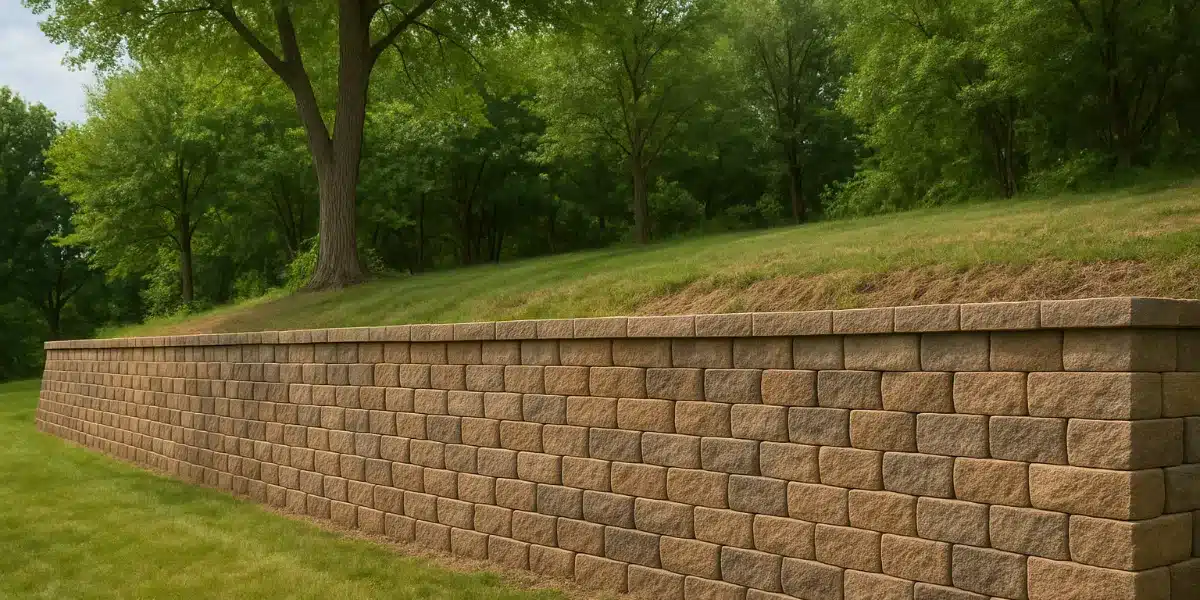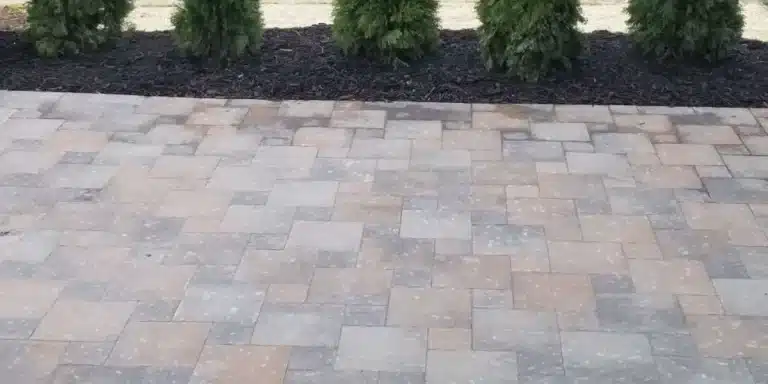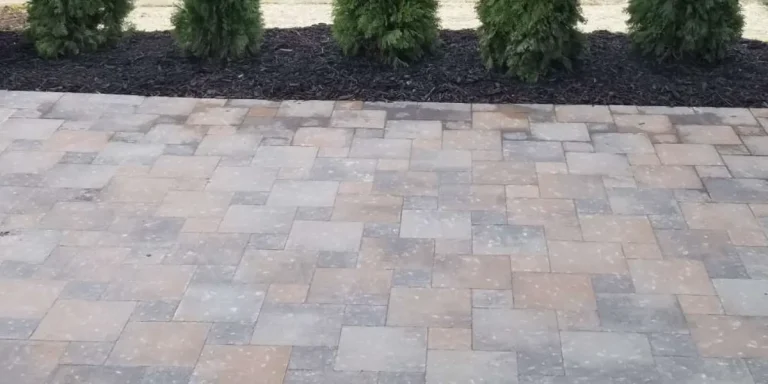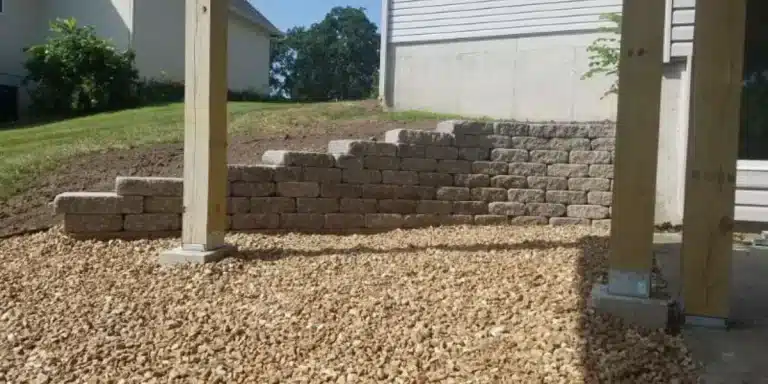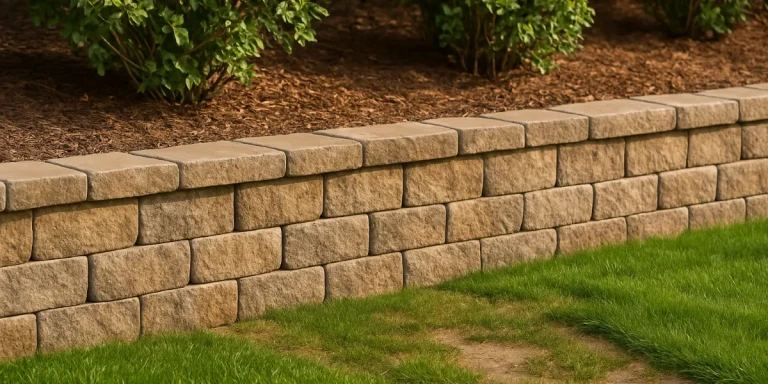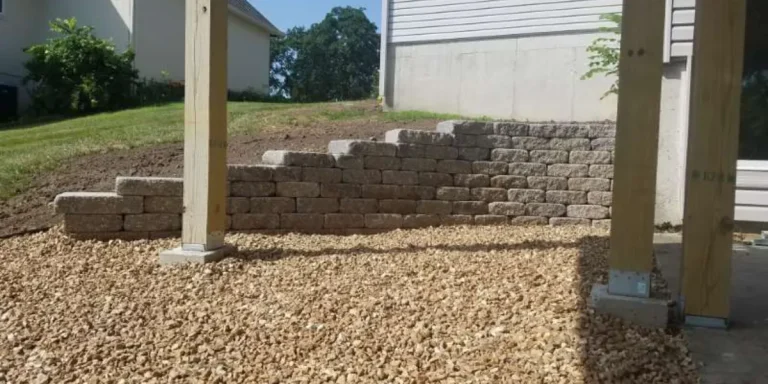What to Do When Your Retaining Wall Starts Leaning
A leaning retaining wall is more than just a cosmetic issue—it’s a serious structural problem that can lead to collapse, property damage, or injury if not addressed properly. Whether your wall is built from timber, stone, concrete block, or modular units, early signs of movement shouldn’t be ignored.
At S&T Landscaping, we help homeowners across Sedalia and Central Missouri evaluate and repair retaining walls before minor issues become major ones. In this guide, we’ll explain why retaining walls lean, what steps to take, and how to prevent future problems.
Why retaining walls start to lean
Retaining walls are designed to hold back soil, manage elevation changes, and protect structures or landscaping from erosion. To do this successfully, they must counteract the pressure of the soil and water behind them. When that pressure becomes too great—or when the wall wasn’t properly constructed to begin with—movement starts, and the wall begins to lean.
At S&T Landscaping, we regularly assess leaning walls across Sedalia and Central Missouri. These are the most common causes we identify during inspections:
Poor drainage behind the wall
Water is one of the most destructive forces acting on a retaining wall. When the wall lacks adequate drainage, water becomes trapped behind it, leading to a buildup of hydrostatic pressure that pushes the structure outward over time.
Contributing factors include:
-
- No gravel backfill: Without a layer of clean, angular gravel behind the wall, water has nowhere to flow and accumulates against the structure.
- Missing or clogged drain pipes: French drains or perforated pipes at the base of the wall are essential to redirect subsurface water away. If these are missing or blocked, pressure rises quickly.
- Lack of weep holes: Especially in concrete block walls, weep holes are necessary to allow excess water to escape through the face of the wall.
Over time, even a well-built wall will struggle if water is consistently allowed to pool behind it. That’s why S&T Landscaping always integrates proper drainage systems into every retaining wall we build or repair.
Inadequate wall design
Not all retaining walls are designed to handle the same conditions. A wall that looks solid on the outside may be structurally underbuilt if it wasn’t engineered for the soil type, slope, or load behind it.
Common design flaws include:
-
- Walls that are too tall without reinforcement or step-backs to distribute pressure
- No tiebacks or geogrid layers to anchor the wall into the soil behind it
- Wrong materials—such as wood or small blocks—used for walls supporting large slopes or retaining heavy soils
Design mistakes often go unnoticed at first, but once the wall begins to lean, the flaws become more apparent. At S&T Landscaping, we inspect the design and structural integrity of failing walls to determine whether reinforcement, partial rebuild, or full replacement is the best path forward.
Base or footing failure
A wall is only as strong as the foundation it’s built on. When the base fails, the rest of the wall is compromised. This is especially common in Missouri, where freeze-thaw cycles and shifting soils are part of the seasonal landscape.
Causes of base failure include:
-
- Poor soil preparation: If the base wasn’t compacted properly, the wall may settle unevenly or shift over time.
- No gravel or structural footing: Retaining walls should sit on a stable layer of compacted gravel—not directly on topsoil.
- Frost heave: In winter, moisture in the soil freezes and expands, lifting sections of the wall and causing cracks or movement when the ground thaws.
If your wall is leaning at the base or has visible cracks near the bottom, it's likely experiencing some form of footing failure. Our team at S&T Landscaping specializes in rebuilding walls with proper base materials and compacted subgrades to prevent future settling.
Soil movement and overloading
Sometimes the pressure behind the wall increases unexpectedly due to changes in the environment or added weight. Even a properly built wall can lean if the load exceeds what it was designed to handle.
Factors that increase soil pressure include:
-
- Heavy landscaping or hardscaping: Placing patios, sheds, or large planters above the wall adds vertical load it may not be built to resist.
- Vehicle traffic: Driving or parking near the top edge of a wall introduces dynamic loads that accelerate leaning and cracking.
- Expansive clay soils: Common in Missouri, clay expands when wet and contracts when dry. These volume changes can apply inconsistent pressure to the wall throughout the year.
- Tree roots and burrowing animals: Roots from nearby trees can push against the wall, while animals may loosen the soil beneath or behind it.
In these situations, S&T Landscaping may recommend regrading, reducing surface load, or rebuilding with reinforced wall systems capable of handling the conditions long-term.
When you notice a retaining wall beginning to lean, it’s usually the result of one or more of these factors working together. Early intervention can often save part of the structure and reduce costs. That’s why S&T Landscaping provides detailed assessments and customized retaining wall repair or replacement solutions built to withstand Missouri’s terrain and climate.
What to do if your retaining wall is leaning
A leaning retaining wall is a warning sign that the structure is failing. Unfortunately, these issues don’t fix themselves. The longer you wait, the more pressure builds behind the wall—raising the risk of collapse and increasing the cost of repairs. Whether the lean is subtle or significant, taking early action is essential.
Here’s what you should do if you notice your retaining wall starting to shift:
1. Stop adding weight near the wall
Additional weight from hardscaping, vehicles, or landscaping features can dramatically increase pressure behind an already compromised wall. To reduce stress on the structure:
-
-
- Remove planters, patio furniture, and decorative stone from directly behind or on top of the wall.
- Avoid using the area for storage or placing any temporary structures there.
- Keep vehicles, mowers, and equipment away from the top edge of the wall—especially during wet weather when the soil is saturated and more prone to movement.
-
Minimizing surface load helps reduce additional stress while you evaluate the next steps.
2. Look for drainage issues
Water is often the root cause of a leaning wall. Poor drainage leads to hydrostatic pressure building up behind the structure, forcing it outward.
Here’s what to look for:
-
-
- Standing water or soggy areas behind or near the wall
- Water seeping through joints or block faces
- Clogged or missing downspouts near the wall
- Overflowing gutters or pooling runoff from nearby hard surfaces
-
If you identify drainage problems, take temporary steps to redirect water while you await a professional evaluation. At S&T Landscaping, we integrate drainage solutions like French drains, backfill gravel, and gutter redirection into every retaining wall repair or rebuild to prevent future failures.
3. Avoid DIY fixes
It’s tempting to try quick patches—especially if the wall only leans slightly—but cosmetic repairs won’t stop the underlying issue. Adding extra concrete, bracing the wall with timbers, or covering cracks may give the illusion of stability but often mask deeper structural problems.
In many cases, DIY repairs:
-
-
- Fail to address foundation issues or water pressure
- Can worsen the problem by trapping more moisture behind the wall
- Void potential warranties or lead to higher costs later on
-
The safest and most effective path is to bring in a professional who understands structural requirements, soil behavior, and proper construction techniques. That’s where S&T Landscaping’s retaining wall specialists come in.
4. Call a retaining wall expert for an on-site assessment
Every leaning wall is different. Factors like height, materials, age, drainage, and surrounding landscape all affect how the wall should be repaired—or whether it needs full replacement.
At S&T Landscaping, we offer:
-
-
- Detailed site evaluations to identify the exact cause of the lean
- Photo documentation and measurements to monitor changes over time if needed
- Custom solutions that may include drainage corrections, partial rebuilds, or complete replacement
- Engineered wall systems when structural reinforcement is required for taller or load-bearing walls
-
Our team works with both residential and commercial properties in Sedalia and surrounding Missouri areas, ensuring the fix fits your landscape—and lasts for years to come.
The earlier you take action, the more options you'll have and the less invasive (and costly) the repair process is likely to be. S&T Landscaping is here to guide you through every step, from inspection to final rebuild, with durable, code-compliant solutions built to withstand Missouri’s terrain and weather conditions.
Can a leaning retaining wall be repaired?
Yes—but the repair approach depends heavily on the extent of the lean, the type of materials used, and the underlying cause of failure. Not all leaning walls require complete replacement. In many cases, strategic interventions can correct the issue and restore the wall’s structural integrity.
At S&T Landscaping, we tailor every retaining wall repair to the specific site conditions, ensuring the most effective and long-lasting solution. Here's what to expect based on the degree of movement:
Minor leaning (under 2–3 inches)
When a wall shows early signs of movement but remains largely intact, repairs are often less invasive and focus on reducing the pressure causing the lean.
Common solutions include:
-
- Drainage upgrades: Adding French drains, gravel backfill, or weep holes behind the wall to relieve water pressure and prevent further shifting.
- Soil relief: In some cases, simply removing excess soil or reshaping the slope behind the wall can reduce the load.
- Reinforcement systems: For smaller block or timber walls, we may install anchors, tiebacks, or geogrid to help stabilize and hold the wall in place.
Minor leans are most cost-effective to address when caught early. Regular monitoring and prompt action are key.
Moderate leaning (3–6 inches)
Walls with more noticeable lean or bulging require partial reconstruction and structural upgrades. The wall has likely already experienced some foundational stress or water damage.
Our approach may include:
-
- Dismantling the affected section: Rebuilding part of the wall with proper reinforcement, including geogrid, drainage pipe, and compacted gravel footing.
- Improving foundation conditions: Correcting inadequate base materials or stabilizing the soil beneath.
- Regrading slopes: If runoff or excess load from above is contributing to the problem, we may reshape the surrounding landscape to better manage water flow and soil pressure.
These repairs help preserve as much of the original wall as possible while reinforcing long-term stability.
Severe leaning (over 6 inches or shifting at the base)
Significant leaning or movement near the base often signals structural failure and usually requires a full rebuild. These walls pose safety risks and are unlikely to recover with surface-level fixes.
In these cases, we may recommend:
-
- Complete removal and replacement of the wall with a modern, engineered system.
- Installation of reinforced block walls, segmental retaining wall systems, or boulder walls, depending on the location and load requirements.
- Comprehensive drainage planning, including French drains, outlet pipes, and surface grading to prevent future failure.
For larger walls or those near homes or driveways, we may also coordinate with engineers or follow local building codes for load-bearing designs. Our team at S&T Landscaping ensures every replacement wall is built with structural integrity and long-term performance in mind.
Whether your retaining wall is showing slight movement or leaning several inches, it’s important to address the issue before it worsens. At S&T Landscaping, we provide honest assessments and custom repair or replacement options that match the scope of the problem and the unique conditions of your property.
A real-world example from the Sedalia area
A client in Pettis County contacted us after noticing their timber retaining wall bulging in the center. Water was pooling at the base after rain, and soil was spilling out near the ends. We identified poor drainage and insufficient structural support as the primary issues.
Our team at S&T Landscaping replaced the failing wall with a new concrete block retaining wall system, added a French drain behind the wall, and regraded the slope above. The result? A sturdy, long-lasting solution with better drainage and curb appeal—and no further movement.
Service area: Central Missouri retaining wall specialists
S&T Landscaping provides professional retaining wall repair, replacement, and drainage services throughout:
-
- Sedalia
- Pettis County
- Benton County
- Warsaw
- Osage Beach
- Lake Ozark
- Camdenton
- Sunrise Beach
- Laurie
- And surrounding towns in the Lake of the Ozarks and Central Missouri region
Don’t wait—get expert help for your leaning wall today
A leaning retaining wall is a warning sign, not a minor cosmetic flaw. The sooner you address the problem, the more options you’ll have—and the more likely you can avoid a total rebuild.
Contact S&T Landscaping today to schedule an on-site inspection. Our experienced team will assess your wall, identify the root cause, and recommend a durable solution that fits your property and budget.
We proudly serve Sedalia and surrounding Missouri communities with expert hardscaping, drainage, and grading services. Let us help you restore safety, structure, and value to your landscape.

